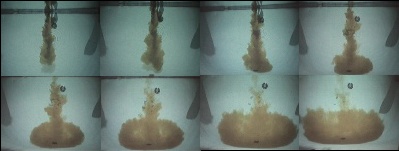The following article is from Kim Skinner — part of the research team of onBalance. I received this via email from Kim a few days ago. Enjoy.
__________________________________________________________________________
By Kim Skinner
Although onBalance debunked the Acid Column Myth in the Journal of the Swimming Pool and Spa Industry many years ago, we still regularly get asked in our trade show chemistry classes about its validity. We would like to recount what the myth is, why it is wrong, why following the practice could damage your pools (costing you money).
The myth:
- If acid is poured in a concentrated area, variously referred to as a column, slug, well or cloud, the alkalinity will be drastically reduced, but the pH will not drop as much as it otherwise would.
- And that if acid is added by walking it around a pool and evenly distributing it throughout the water, the pH will be preferentially lowered, with only a minor decrease of alkalinity.
The plain and simple fact of the matter is that a given amount (or “dose”) of acid added to a fixed volume of water (the pool) will result in an identical reduction of both pH and alkalinity. Every time. No matter how it is added. That’s the rule, that’s science, and it can easily be demonstrated at poolside by anyone with a test kit. The only real chemical difference between the two addition methods is the time required for the acid to blend throughout the entire pool.
Now – what really happens when acid is added in a concentrated fashion to a pool? Since acid is noticeably heavier than water, the acid sinks to the bottom, and flows to the lowest part of the pool. If that lowest part happens to include an operating main drain or an operating suction-side cleaner, the concentrated acid dose winds up in the circulation system.
In fact, we have performed experiments adding acid in this manner and have verified that this method can indeed create conditions where the pH of the water at the bottom of the pool is less than 2.5.

The picture above depicts two quarts of “dyed” acid being added to the deep-end of a pool and with the equipment shut off. The acid puddle remained that way for more than 30 minutes.
Although the movement of the water will eventually dilute and blend the acid into the rest of the pool, the initial contact of concentrated acid can potentially etch the plaster it touches, and attack the circulation system it flows through. Even adding several smaller “slugs” of concentrated acid will result in this puddling of acid on the bottom – try adding dye to your acid and watch it. Its fun – as long as you are not worried about uniformly etching the bottom of the pool!
Of course, etching the plaster and eating the components of the circulation system is generally considered a bad thing… yet the proposed treatment process (“slugging” the acid) recommends this potentially damaging treatment technique, all for the sake of a theoretical, unfounded attempt at chemistry manipulation. Even if it worked (which it doesn’t), would it be worth the risk?
What is the right way? The best way to manually add acid to a pool is to pre-dilute the acid and to add it by “walking” it around the perimeter of the pool, pouring it evenly, close to the surface, and slowly enough to minimize splashing. When added in this fashion, the acid blends throughout the pool water faster, and the pool is protected from low pH.
In pools treated with the acid dilution and distribution method, the lowest pH levels measured next to the plaster were in the 7.1-7.2 range. (Repeat – once the acid addition was blended throughout the water, the end-result pH and total alkalinity reduction was identical, no matter how the acid was added.)
It is time to get this nonsense laid to rest, and stick to what is scientifically sound and that we all know works. And quit risking damage to pools in our care.
A more detailed water chemistry report on this topic (by onBalance) can be viewed by clicking below.
http://www.poolhelp.com/wp-content/uploads/2017/05/JSPSI_V1N2_pp16-30.pdf


Comments
Have there been any tests done with acid injection systems? I happen to use a Hasa pH Adjuster (with sodium bisulfate) on my personal pool, and I am very happy with it. I would think that introducing acid via the return system would be the most accurate way to achieve a blend and not have plaster etching. If we are discussing the best way to avoid damage to pools, I would be interested in seeing some studies on introducing the acid in this fashion.